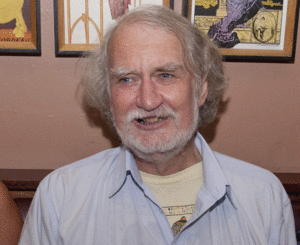Morwood Mike
Contents
[hide]Michael Morwood October 1950 - July 2013

Career
Mike Morwood was born in Auckland completed his first two degrees at the University of Auckland graduating MA in 1974. His thesis research essay was on obsidian utilisation [1]. He published on New Zealand archaeology, before settling in Australia.
His subsequent academic career was as a PhD student at ANU where his thesis topic was Art and stone: towards a prehistory of central-western Queensland. He then had posts with Queensland State Archaeology Branch of the Department of Aboriginal and Islander Affairs, the University of New England and latterly at the University of Wollongong where he was a Professor at the School of Earth and Environmental Studies.
His research interests in rock art persisted throughout his Australian career and he was recognised particularly in Australia for that that but it was his interest in the lands to the north west of Australia that brought world-wide recognition. Pursuing a fascination with the lithic materials found on islands immediately east of the Wallace Line he and his co-workers first demonstrated they were ancient - and must be the product of pre-sapiens people crossing that water gap. However the most stunning discovery made by the team he co-lead was that in 2003 in Flores of Homo floresiensis, a diminutive late Pleistocene hominin, often called the hobbit. Its relationship to its relatives has been controversial and continues to be, but Morwood's initial conclusion that it was a dwarfed species derived from Homo erectus seems to be holding up. This discovery placed Morwood on a world stage and must rank as one of the archaeological finds of the century.
Morwood made particular efforts to ensure his work was presented in a form for the general public, particularly in his book on the Hobbit finds[2] and in public lectures, including a series in New Zealand in 2009.
He was a Fellow of the Australian Academy of the Humanities.
In 2012 Mike was the recipient of the Australian Archaeological Association's prestigious Rhys Jones medal [3]. Their press release on his death can be read here.
At the time of his Flores discoveries his New Zealand roots seemed to be unrecognised by the New Zealand media but at the time of his death they were, if belatedly [4]
See also the New York Times obit[5].
Harry Allen contributed an obituary to AINZ 56(3):124-125.
Bibliography (NZ)
1974 A functional analysis of obsidian flakes from three archaeological sites on Great Barrier Island and one at Tokoroa. Records of the Auckland Institute and Museum 11: 77–99.
1975 Mahurangi: site survey and ethnohistory. NZAA Newsletter 18(2):82-89.
Bibliography (Other)
See [6]
References
- Jump up ↑ Experiments with obsidian: functional and typological implications. University of Auckland MA research essay
- Jump up ↑ The Discovery of the Hobbit: The Scientific Breakthrough that Changed the Face of Human History - Mike Morwood and Penny Van Oosterzee, 2007 Random House.
- Jump up ↑ Rhys Jones medal award. http://www.australianarchaeology.com/awards/rhys-jones-medal/mike-morwood/ Accessed 2013
- Jump up ↑ Kiwi who helped find 'hobbits' dies http://www.nzherald.co.nz/world/news/article.cfm?c_id=2&objectid=10902412 Accessed July 2013
- Jump up ↑ Michael J. Morwood, Archaeologist Who Helped Find ‘New Human,’ Dies at 62. http://www.nytimes.com/2013/08/06/science/michael-j-morwood-archaeologist-who-helped-find-new-human-dies-at-62.html?_r=0 Accessed August 2013
- Jump up ↑ Professor Michael "Mike" Morwood https://cas.uow.edu.au/members/UOW094308.html Accessed 2013.
